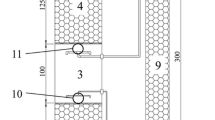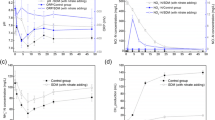Abstract
Given that the consumption of organic substances entails costly biodesulfurization, the characteristics of the bacterial community in a reactor should be determined to increase the desulfurizing rate under low organic loading condition. In this study, the bacterial community distribution in the expanded granular sludge bed reactor used to treat sulfate-containing wastewater with low organic loading rate was determined by polymerase chain reaction-denaturing gradient gel electrophoresis (PCR-DGGE) and 16S rDNA clone library analyses. DGGE results showed that the predominant bacteria were stable and accounted for ~90 % sulfate removal efficiency. Differences in band positions and intensities indicated that the distribution and abundance of bacteria were affected by their positions in the reactor. Typical bands were identified in the bacterial community comprising Desulfovibrio, Desulfomicrobium, Thiomonas, Acinetobacter, Bacteroidetes, and Chloroflexi. Their functions in the reactor were also discussed. The possible links between the functional and microbial responses were also investigated based on the characteristic and spatial distribution of each bacterium in consortium.




Similar content being viewed by others
References
Sheng YX, Cao HB, Li YP et al (2010) Effects of various pretreatments on biological sulfate reduction with waste activated sludge as electron donor and waste activated sludge diminution under biosulfidogenic condition. J Hazard Mater 179:918–925
Liamleam W, Annachhatre AP (2007) Electron donors for biological sulfate reduction. Biotechnol Adv 25:452–463
Choi E, Rim JM (1991) Competition and inhibition of sulfate reducers and methane producers in anaerobic treatment. Water Sci Technol 23:1259–1264
Joke G, Brigitte B, Ludo D et al (2006) DsrB gene-based DGGE for community and diversity surveys of sulfate-reducing bacteria. J Microbiol Methods 66:194–205
Sipma J, Osuna MB, Lettinga G et al (2007) Effect of hydraulic retention time on sulfate reduction in a carbon monoxide fed thermophilic gas lift reactor. Water Res 41:1995–2003
Sahinkaya E (2009) Microbial sulfate reduction at low (8 °C) temperature using waste sludge as a carbon and seed source. Int Biodeter Biodegrad 63:245–251
Wolicka D, Jarzynowska L (2012) Microbiological reduction of sulphates in salty environments and mineralogical characterization of the transformation products. Geomicrobiol J 29:528–536
Wattiau P, Renard ME, Ledent P et al (2001) A PCR test to identify bacillus subtilis and closely related species and its application to the monitoring of wastewater biotreatment. Appl Microbiol Biotechnol 56:816–819
Fujii T, Watanabe S, Horikoshi M et al (2011) PCR-DGGE analysis of bacterial communities in funazushi, fermented crucian carp with rice, during fermentation. Fish Sci 77:1–7
Ji GD, Liao B, Tao HC et al (2009) Analysis of bacteria communities in an up-flow fixed-bed (UFB) bioreactor for treating sulfide in hydrocarbon wastewater. Bioresour Technol 100:5056–5062
Kim YM, Chon DH, Kim HS et al (2012) Investigation of bacterial community in activated sludge with an anaerobic side-stream reactor (ASSR) to decrease the generation of excess sludge. Water Res 46:4292–4300
APHA (1989) Standard methods for the examination of water and wastewater. American Public Health Association, New York
Isabel NG, Wang ET, Florina R et al (2006) Characterization of bacterial community associated to biofilms of corroded oil pipelines from the southeast of Mexico. Anaerobe 12:122–133
Zhao YG, Wang AJ, Ren NQ (2010) Effect of carbon sources on sulfidogenic bacterial communities during the starting-up of acidogenic sulfate-reducing bioreactors. Bioresour Technol 101:2957–2959
Herto DA, Tsukasa I, Satoshi O (2007) Functional bacterial and archaeal community structures of major trophic groups in a full-scale anaerobic sludge. Water Res 41:1554–1568
Tatsunori N, Shinya S, Yoko Y et al (2002) Successive changes in community structure of an ethylbenzene-degrading sulfate-reducing consortium. Water Res 36:2813–2823
Thangaraj K, Atya K, Hemant JP (2008) Characterization of diverse acinetobacter isolates for utilization of multiple aromatic compounds. Bioresour Technol 99:2488–2494
Juan PM, Rovira R, Alvarez-Hornos FJ et al (2010) Bacterial community analysis of a gas-phase biotrickling filter for biogas mimics desulfurization through the rRNA approach. Chemosphere 80:872–880
Sass H, Cypionka H, Babenzien HD (1997) Vertical distribution of sulfate-reducing bacteria at the oxic-anoxic interface in sediments of the oligotrophic lake Stechlin. FEMS Microbiol Ecol 22:245–255
Karen B, Werner M, Ulrich S (2000) Behavior of sulfate reducing bacteria under oligotrophic conditions and oxygen stress in partical-free systems related to drinking water. FEMS Microbiol Ecol 32:215–223
Sara B, Lorenzo B, Daniele D et al (2009) Biodiversity of prokaryotic communities in sediments of different sub-basins of the Venice lagoon. Res Microbiol 160:307–314
Stefan JG, Frederick CMJ, Yitzhak H et al (2004) Similarity of bacterial communities in sawdust- and straw-amended cow manure composts. FESM Microbiol Lett 233:115–123
Cord S, von Claudia W, Regin H et al (2002) Microbial structure of an anaerobic bioreactor population that continuously dechlorinates 1,2-dichloropropane. FESM Microbiol Ecol 39:229–237
Vossoughi M, Shaken M, Alem Zaden I (2004) Performance of anaerobic baffled reactor treating synthetic wastewater influenced by decreasing COD/SO4 ratios. Chem Eng Proc 42:811–817
Cox HHJ, Deshusses MA (2002) Co-treatment of H2S and toluene in a biotrickling filter. Chem Eng J 87:101–110
Daniel K, Andreas T, Heribert C (1998) Strategies of sulfate-reducing bacteria to escape oxygen stress in a cyanobacterial mat. FESM Microbiol Ecol 25:89–96
Knut F, Daniel K, Ulrike S et al (1996) A common pathway of sulfide oxidation by sulfate-reducing bacteria. FEMS Microbiol Lett 144:129–134
Acknowledgments
This work was supported by The National High Technology Research and Development Program of China (2011AA060702, 2011AA060904) and the Open Funding Project of the National Key Laboratory of Biochemical Engineering (2012KF-07).
Author information
Authors and Affiliations
Corresponding authors
About this article
Cite this article
Zhang, K., Cao, X., Sheng, Y. et al. Spatial distribution of bacterial community in EGSB reactor treating synthetic sulfate-containing wastewater at low organic loading rate. Chin. Sci. Bull. 59, 54–61 (2014). https://doi.org/10.1007/s11434-013-0043-2
Received:
Accepted:
Published:
Issue Date:
DOI: https://doi.org/10.1007/s11434-013-0043-2




